Everyone is hoping for their feet to touch bottom. The coronavirus has washed over our lives in a tsunami of uncertainty. The prospect of serious illness, hospitalization, or death is tangible. ‘Social distancing’ and ‘shelter in place’ orders in many jurisdictions clarify that this time it’s for real. Empty supermarket shelves add to the unsettling feeling that, in the end, there may not be enough help for everyone.
Where I live, the restrictions on movement are not yet as severe as in many places. For now, I can’t help noticing a welcome phenomenon unfolding. On warm afternoons, people are hitting the footpaths and trails in numbers. They are grabbing their bikes, dogs, and family members and strolling along the river in micro-gaggles, riding along the bike lanes in mini-peletons, and huffing their way up hills in clusters of twos and threes. There is a little extra spacing between them for sure. And those passing in opposite directions give each other a wider berth. But people are out. A couple of days after the vernal equinox, the warming rays of the sun feel good and the air feels exceptionally clean.
 With many workplaces closed and no coffee shops or restaurants available, everyone is forced to spend an unusual amount of time at home. This puts new demands on creativity, especially for those with children at home. The afternoon walk starts to look like an attractive way to break up the day. And this is not the only reason to be outside. For me, the idea of making my lungs work is also a type of proactive therapy. If I get the virus, I want my respiratory system to be in as good a fettle as possible so my body can do the self-defense work I’m hoping it will do. There has rarely been such a palpable motivation to exercise.
With many workplaces closed and no coffee shops or restaurants available, everyone is forced to spend an unusual amount of time at home. This puts new demands on creativity, especially for those with children at home. The afternoon walk starts to look like an attractive way to break up the day. And this is not the only reason to be outside. For me, the idea of making my lungs work is also a type of proactive therapy. If I get the virus, I want my respiratory system to be in as good a fettle as possible so my body can do the self-defense work I’m hoping it will do. There has rarely been such a palpable motivation to exercise.
The timing of these forced lifestyle changes is fortuitous for those of us in the northern hemisphere. The season is turning. The worst of the winter blizzards are over. The frosts are gentler and the frigid winds have mostly abated. Daffodils and crocuses are poking up in the yard. Buttercups offer flashes of yellow on the hillsides. Buds on the serviceberries are starting to swell and red osier dogwood twigs are flush with color. Flickers and nuthatches are active on street trees. A purple finch came by an old nest yesterday to see if it could be spruced up for this year’s clutch. Ospreys and meadowlarks will return shortly.
When mental space threatens to close us all in, part of what gets people outside is the opportunity to see life proceeding as normal, unfazed by a global pandemic. It is certainly nice to see people out but it is also tremendously reassuring to see songbirds and flowers doing what they have done for millennia. Creeks won’t stop filling with snowmelt this year and blossoms won’t be prevented from appearing on trees. Three lazy horses in a field by the road watched me go by on my bike the other day and asked with their eyes “what’s the hurry?” It is calming to see the biological world proceeding as normal.
Of course, the signals of spring now proving so uplifting depend entirely on the same biological forces that have brought us the coronavirus. The very same processes of mutation are responsible for creating novelty and diversity across all the different kingdoms of life. The instructions for protein synthesis and mechanisms for self-defense that give pathogens their virulence are related to those that give horses their strength. Viruses are elements of the planet’s biodiversity, roaming the world opportunistically, following the same biological laws that steer purple finches and serviceberries in their own push to survive and reproduce. Without viruses, no spring blossoms. Without a vigorous microbiome, no growth or decay.
 How should this make us feel today? Is this wild world, operating independently of human control, one we should fear or one we should embrace? This question has an edge now.
How should this make us feel today? Is this wild world, operating independently of human control, one we should fear or one we should embrace? This question has an edge now.
More than anything else it is evident today how the biological world is inescapably our world, the world in which we have no option but to dwell. We can create the illusion of insulating ourselves from it, in comfortable homes and in brightly lit supermarkets. We can spend our time with people, rather than with purple finches. But our isolation from biological forces is always temporary, a suspension of our exposure to a world driven by the same organic imperatives for four billion years. People call this time the “Anthropocene,” the human age. But whatever is distinctively human about this age, it is nested completely within a much larger set of governing principles.
Frightening as the coronavirus is, this encircling biological truth is not something to fear. But it is something to remember. And when our feet find secure ground again, which they will, our species should perhaps try to occupy a different relationship to the biological world. This new relationship may have better policies in place for keeping our biotic surroundings at bay in a crisis. But perhaps it will have more reason to protect and cherish them in times of calm.


What I admire most about this piece is its timeliness. I too have had the urge to write about this current crisis and its philosophical implications, but I have so far resisted it because I felt too trapped in the middle of this “story” and too uncertain as to how it will end. The themes you weave throughout this piece reassure me that one can write sensitively and optimistically from within a crisis and not only from beyond one. By working with time on a deep scale – both looking backward and forward – you hold this pandemic firmly in perspective. Well done and thank you for a reprieve from the doom and gloom we’re all too curious about right now.
LikeLike
Beautiful and reassuring text!
LikeLike